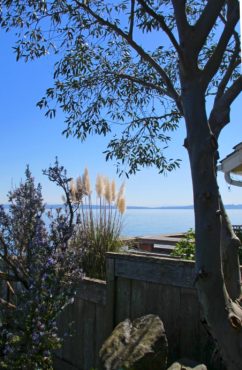
West Sound residents seldom forget how fortunate they are to be surrounded by water. Thousands of miles of shoreline influence everyday activities, especially for those lucky enough to be the stewards of waterfront property.
The thought of a seaside garden conjures up romance, fun, beauty, sunshine, children laughing, friends sharing stories around a fire — but that same garden can be a tough place for plants. The soil can be poor and loose, the sun fierce and the wind buffeting.
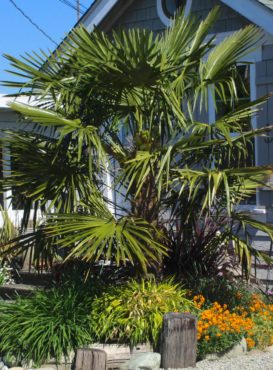
Wind-driven salt water can coat the foliage with salt, and the tides can inundate the plants’ roots. On the other hand, the fairly constant temperature of the water moderates the air temperature and protects coastal plants. Surprisingly, many plants can do well in these conditions.
Choosing the right plant for the right place is very important along the waterfront. Consider the mature size and form of each plant, its salt tolerance, the soil conditions and sun exposure.
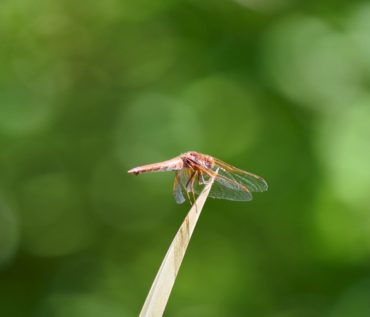
Using as many native plants as possible in the design will support local fauna and provide a low-maintenance garden once the plants are established. More exotic plants can be used upland. Siting taller trees and shrubs off to the sides will help preserve views and avoid having to prune.
Use a combination of grasses, perennials and low shrubs along the paths to the beach, and keep lawns to a minimum. The key is to not coddle the plants so they can develop slowly and not produce lanky, tender growth unable to withstand the rigors of exposure.
Now imagine walking from the water’s high-tide margins toward the upland gardens. These are some of the plants that colonize the shifting sediments closest to the water’s edge (plants marked with * are native to Washington state):
-
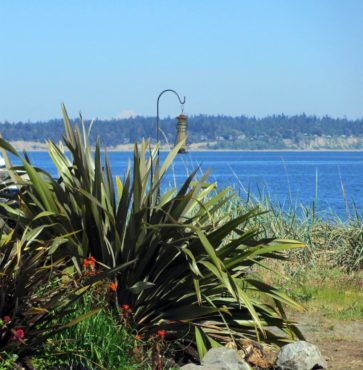
New Zealand flax thrives near the shore. Elymus mollis* (dune grass) is a blue rhizomatous grass great at stabilizing beach sand and fine gravel. Looks wonderful among driftwood.
- Artemisia stelleriana (beach wormwood) has lovely silver foliage and yellow flowers.
- Grindelia integrifolia* (gumweed) has sticky, yellow daisy-like flowers.
- Lupinus littoralis* (seashore lupine) is a spreading blue-flowering native lupine, good at holding loose sandy soil.
- Atriplex sp* (saltbush) is a low-growing shrub.
Visit Fay Bainbridge park on Bainbridge Island to see some of these plants and others growing among the huge driftwood. For more inspiration, take the Kingston ferry to Edmonds — a well-designed waterfront surrounds the Edmonds ferry terminal.
Beyond the loose soils and driftwood, the plant palette widens considerably. Occasional salt-water spray as well as the drying winds of storms may reach the plants. A mix of perennials, grasses and low shrubs create a transition to the upland gardens. A wind-sculpted tree can add drama.
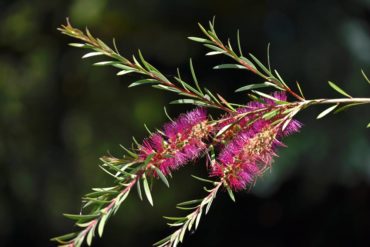
Fragaria chiloensis* (coastal strawberry) has shiny, dark, evergreen foliage and white flowers. It is drought-tolerant and creates a dense ground cover.
Armeria maritima* (sea thrift) foliage resembles soft grass and surprises with an explosion of pink flowers held on stems like lollipops. Salt-water inundation does not bother it at all.
Juniperus* (shore juniper) hugs the ground as it spreads. Other low-growing junipers can also be used for a variety of color and texture.
Sisyrinchium californicum* (golden eyed grass) offers a vertical contrast to the ground-hugging plants, as do Deschampsia cespitosa* (tufted hairgrass), Scirpus maritimus* (seacoast bulrush) and Carex obnupta* (slough sedge).
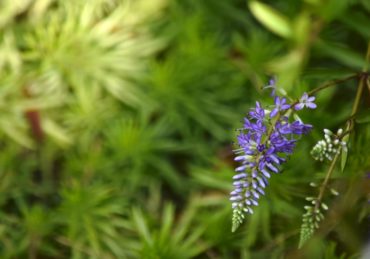
Arctostaphylos uva-ursi* (kinnikinnick), a wonderful evergreen groundcover with urn-shaped flowers and red berries, looks especially nice hugging some rocky outcrops.
Sedum spp* (stonecrop), with its fleshy foliage, thrives in the sunny, exposed areas of the coast. It’s especially well suited to a rock garden and along the edges of paths. Sedum spp mix beautifully with Dianthus spp (pinks), Thymus lanuginsus (wooly thyme) and Delosperma cooperi (cooper’s hardy ice plant). The explosion of blossoms and the variations in foliage color and texture can create a beautiful tapestry.
A planting of spiky yuccas could nestle into a bed of Rosmarinus officinalis ‘Prostratus’ (trailing rosemary).
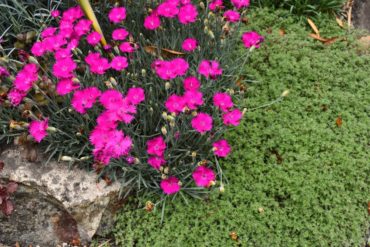
Pines such as Pinus contorta* (shore pine) and Pinus thunbergii (Japanese black pine) are well-suited for these conditions and can become a lovely, wind-swept sculpture, as can Arbutus menziesii* (Pacific madrone). For a more exotic look, Eucalyptus pauciflora (snowgum) has gorgeous peeling bark, light branches that catch the smallest breezes, and interesting seedheads. For a kiss of the tropics, try Trachycarpus fortunei (windmill palm).
Walking farther, imagine the quilt of soft colors and textures that could be created by combining Santolina chamaecyparissus (lavender cotton), Potentilla anserina* (silverweed), Potentilla gracillis* (graceful cinquefoil), Aster subspicatus* (Douglas aster), Nepeta sp (catmint), Rosmarinus officinalis (rosemary), Echinops sp (globe thistle), Lavandula spp (lavender), California poppies, Helianthemum spp (sun roses) and various Calluna spp (heather) and Erica spp (heath).
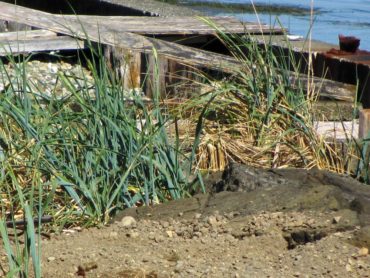
Various shrubs are suitable for creating a windbreak and dissipating the buffeting winds of storms. Rosa nutkana* (nootka rose), Gaultheria shallon* (salal), Symphoricarpos albus* (snowberry) and Rosa rugosa (rugosa rose) create attractive thickets and can be kept pruned to a desired height. Several varieties of rugosa roses are available, some single, some double, and all wonderfully fragrant.
Morella californica* (Pacific wax myrtle), Holodiscus discolor* (oceanspray) and Vaccinium ovatum* (evergreen huckleberry) are excellent natives worthy of any garden seaside landscape.
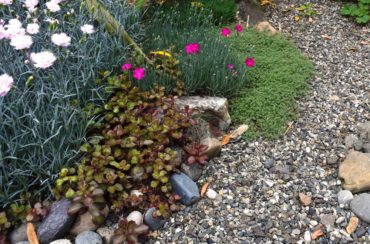
If space allows for a tall evergreen hedge tree, x Cupressocyparis leylandii ‘Moncal’ (‘Emerald Isle’ leyland cypress) is a good choice because it is better behaved than the standard leyland cypress and remains more compact.
Escallonia spp (escallonia) is an attractive blooming evergreen shrub. A grove of Amelanchier alnifolia* (serviceberry) grown as small trees and underplanted with some of the low-growers like the heaths and heathers, asters and catmints would be a lovely sight, and an arbor covered by Trachelospermum jasminoides (star jasmine), a welcoming entry to the protected garden beyond.
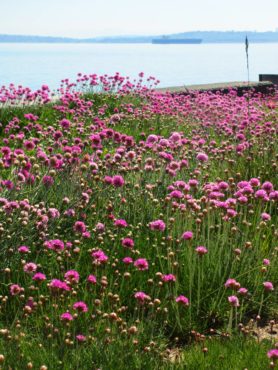
Other great plants that offer even more possibilities for the creation of a unique landscape kissed by the Salish Sea include:
- Pittosporum spp (Australian laurel)
- Phormium spp (New Zealand flax)
- Araucaria araucana (monkey puzzle tree)
- Arctostaphylos spp* (manzanitas)
- Callistemon spp (bottlebrush)
- Baptisia australis (false indigo)
- Ilex verticillata* (winterberry)
- Quercus ilex (holly oak)
- Betula spp (birch)
- Cistus spp (rock rose)
- Hebe spp
- Hemerocallis spp (daylilies)
- Muhlenbergia capillaris (muhly grass)
- Leucanthemum x superbum (shasta daisy)
- Crocosmia spp (montbretia)
- Salvia spp (salvia)
- Achillea millefolium* (yarrow)
Restoration
The natural systems that have formed over millennia have been influenced by the effects of weather, erosion, and wave and tidal action. They have been tested by time. These ecosystems undergo cyclical changes, with the sediments from eroding bluffs replenishing those that washed away in winter storms.
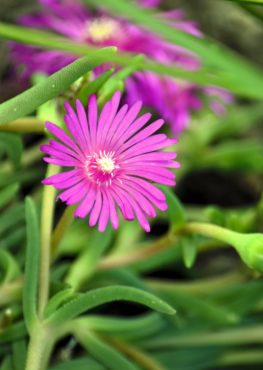
Beaches slope gently and dissipate the energy of waves. Fallen trees help trap sediments and also absorb some of the wave power coming ashore. Dense root systems and stems of plants trap and hold finer sediments.
Trees overhanging the shore provide shade and habitat for countless animals, both in the water and on land. Vegetation helps to dissipate and absorb much of the rain, protecting land from saturation and potential landslides.
It is often possible to balance people’s enjoyment of their property while preserving its natural functions. The Washington Department of Fish and Wildlife has created a very informative guide: “Your Marine Waterfront: A guide to protecting your property while promoting healthy shorelines” (pdf).
In many cases, homeowners can partner with local agencies to restore their land with expertise and financial support or tax savings for the project (link).
Consult your local city or county code or guidelines to inform any projects along the waterfront.





























